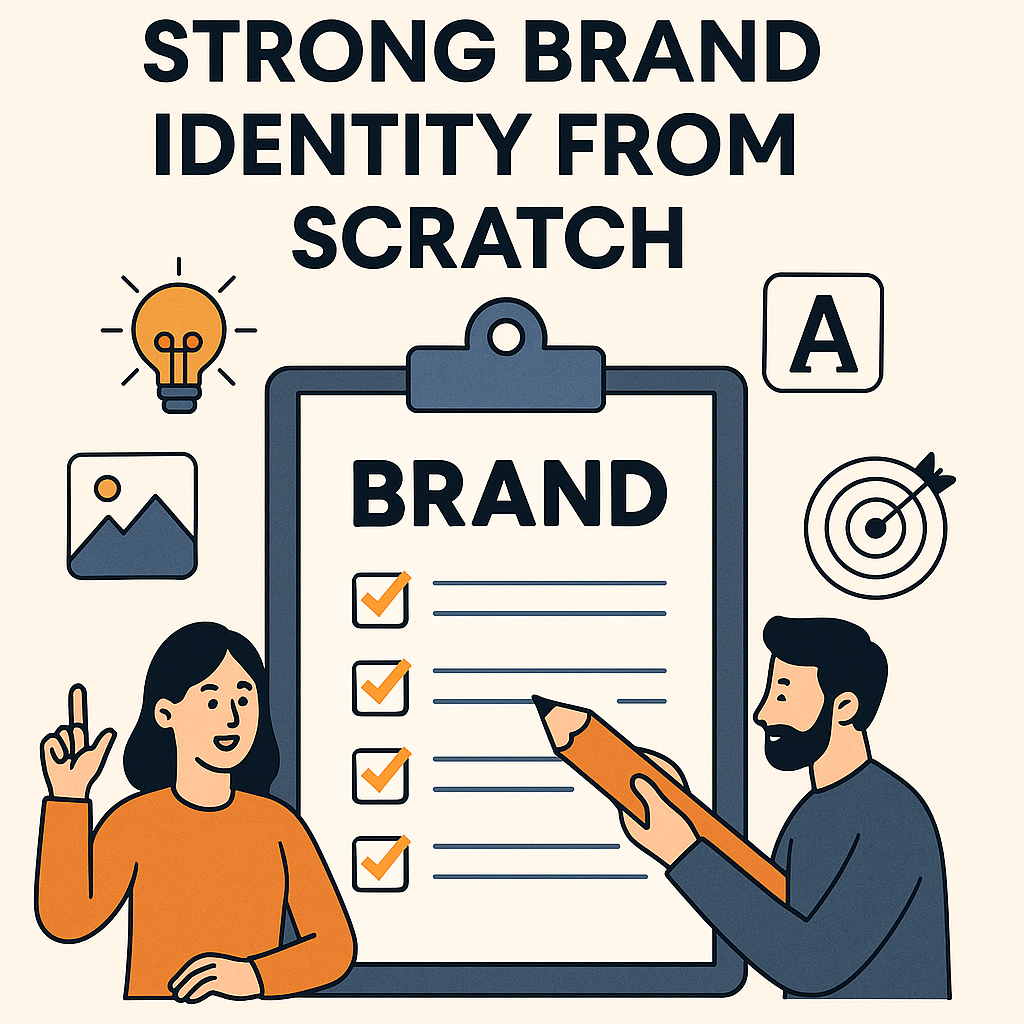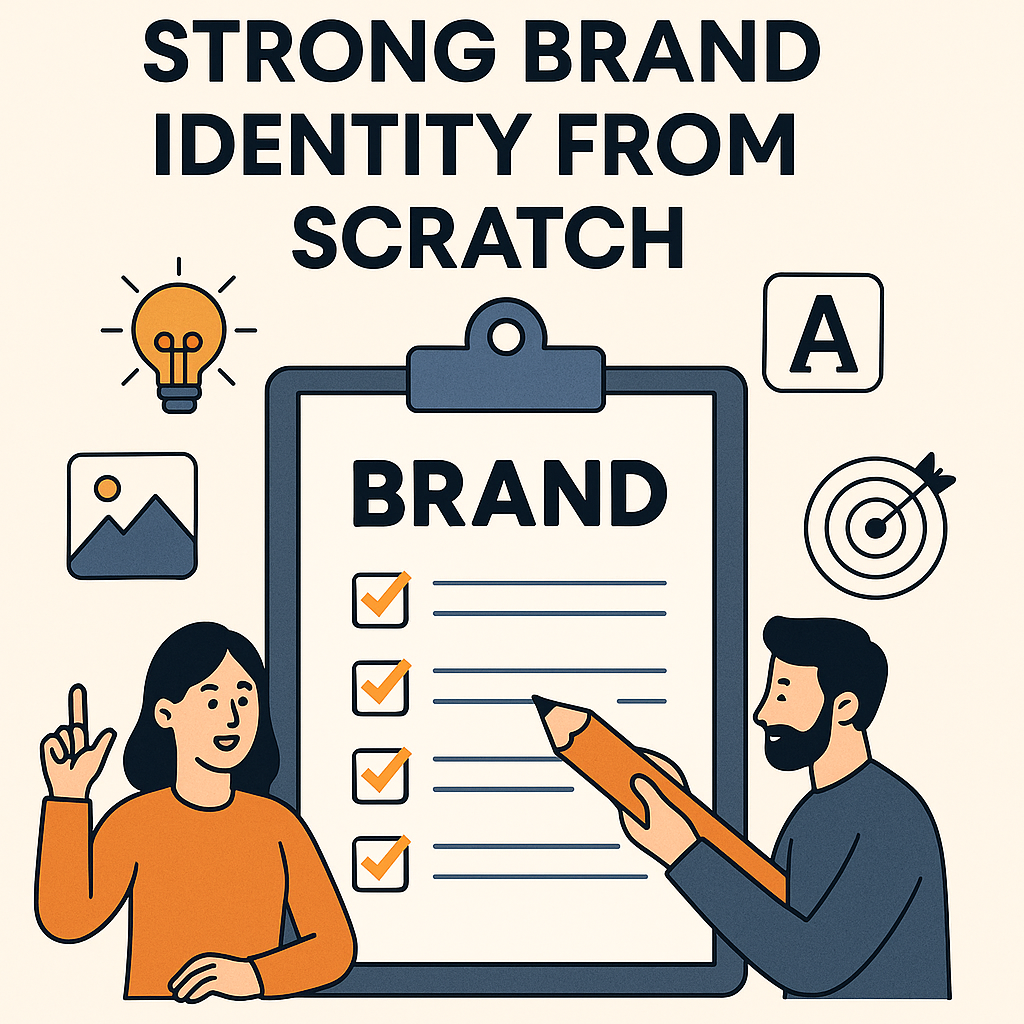Table of Contents
1. Introduction: Why brand identity matters and what this blog will cover.
2. Define Your Brand Purpose and MissionClarifying your brand’s “why” and how it drives every decision.
3. Know Your Target AudienceUnderstanding customer personas to tailor your message and visuals.
4. Craft a Memorable Brand Name and TaglineHow to choose a name and slogan that resonate and are easy to recall.
5. Design a Compelling Visual IdentityChoosing logos, color palettes, typography, and imagery.
6. Establish a Consistent Brand VoiceDeveloping tone and language that reflect your brand personality.
7. Build a Brand Style GuideCreating guidelines for visual and verbal consistency.
8. Apply Branding Across All TouchpointsEnsuring your brand identity is present across your website, social media, packaging, etc.
9. Stay Flexible and Open to EvolutionAdapting your brand identity as your business and audience evolve.
10. Frequently Asked QuestionsAnswers to common branding questions for beginners and small businesses.
11. Final ThoughtsRecap and motivation to start building a strong, authentic brand.
12. SummaryA long-form recap of the entire blog in detailed paragraph format.
How to Build a Strong Brand Identity from Scratch

In today’s overcrowded marketplace, having a powerful brand identity isn’t optional—it’s essential. Whether you’re a solo entrepreneur or building the next big thing, your brand is the face of your business, the essence of your messaging, and the emotional connection you create with your audience. A strong brand identity sets you apart, builds trust, and fosters loyalty. But how do you build a brand identity from scratch? This comprehensive guide walks you through every step of creating a brand that’s authentic, cohesive, and unforgettable.
1. Define Your Brand Purpose and Mission
Your brand identity begins with a crystal-clear understanding of your **brand’s purpose**.
Why do you exist? What problem are you solving, and why should people care? Your brand mission statement should reflect your core values, goals, and commitment to your audience.
For example, [Delits Motion Picture](https://delitsmotionpicture.com) exists to empower businesses with creative visual storytelling and cutting-edge digital content. Your mission will guide everything from your design decisions to yo…
2. Know Your Target Audience
Before building a brand identity, you must understand **who you’re speaking to**. Identify your ideal customer’s demographics, behaviors, pain points, and desires. Create audience personas that include age, gender, location, interests, and goals. This helps shape your tone, visual design, and communication. Remember, a brand trying to speak to everyone ends up connecting with no one. A focused identity builds stronger emotional ties.
3. Craft a Memorable Brand Name and Tagline
Your brand name is the first thing people will associate with your business. Choose a name that is unique, easy to pronounce, and reflects your identity. The **tagline** is your elevator pitch in a sentence—catchy, concise, and emotionally resonant. For example, Nike’s “Just Do It” is simple yet powerful. A great name and tagline give your brand immediate recall value and set expectations.
4. Design a Compelling Visual Identity
Visual identity includes your **logo, brand colors, typography, and imagery**. These elements must align with your brand’s personality and mission. Choose a color palette that evokes the right emotion—blue for trust, red for energy, green for growth, etc. Keep typography legible and on-brand. A professional logo, whether minimalist or illustrative, is your brand’s visual anchor. For free logo inspiration, check out [Looka](https://looka.com).
5. Establish a Consistent Brand Voice
Your brand voice is how your brand speaks to the world. Is your tone friendly, authoritative, quirky, or sophisticated? Consistency in voice builds recognition and trust. Use the same tone across platforms—social media, website, packaging, and emails. Create a **brand voice guide** to help your team write and communicate in a unified tone. Even your captions and hashtags should reflect this personality.
6. Build a Brand Style Guide
A **brand style guide** is your brand’s playbook. It defines how your brand should look and sound across different platforms. Include rules for logo usage, typography, color codes, image style, tone of voice, and spacing. This guide ensures consistency even when multiple people work on your brand. It also protects brand integrity as you scale your business.
7. Apply Branding Across All Touchpoints
Now that your brand identity is defined, apply it everywhere—your website, social media profiles, packaging, business cards, and email signatures. Use the same fonts, logo sizes, and tone. A consistent experience across all touchpoints increases trust and brand recall. Even subtle elements like favicon or loading animations should feel cohesive with your brand personality.
8. Stay Flexible and Open to Evolution
Brands evolve with time, trends, and audience expectations. While your core values should remain consistent, your brand identity must be flexible. Rebranding is okay when it supports your growth. Keep measuring brand perception, audience feedback, and competitor moves. Iterate when needed, but always stay true to your purpose.
You can also revisit our previous blogs for deeper insights:-
[What is Branding? A Complete Guide for Beginners](https://delitsmotionpicture.com/what-is-branding-a-complete-guide-for-beginners)-
[The Psychology Behind Effective Branding](https://delitsmotionpicture.com/the-psychology-behind-effective-branding)

Frequently Asked Questions**
Q1: How long does it take to build a brand identity?**
A: It depends on the complexity of your brand. A basic brand identity can take a few weeks, while a full-scale identity system may take months of research, design, and testing.**
Q2: What tools can I use to build a brand identity?**
A: Canva, Looka, Adobe Express, and Figma are great tools for beginners. For more professional results, consider hiring a branding agency.**
Q3: Can a small business have a strong brand identity?**
A: Absolutely. In fact, smaller brands can build deeper emotional connections with niche audiences and craft more personal experiences.
Final Thoughts
Building a strong brand identity from scratch may seem daunting, but it’s one of the most rewarding investments for your business. A great brand doesn’t happen overnight—it is built through intention, creativity, and consistency. Start by defining your mission, understanding your audience, and crafting a voice and visual that speaks to them. Stay consistent yet open to growth. With time, your brand identity will become a powerful magnet that draws customers, builds loyalty, and sets you apart from the n…
Summary
This blog provides a comprehensive roadmap for creating a strong and memorable brand identity from scratch. It begins by emphasizing the foundational importance of having a clear purpose and mission—defining the “why” behind your brand. Without this clarity, your branding efforts may lack direction and fail to emotionally connect with your audience. We explored how understanding your target audience’s needs, preferences, and behaviors shapes the tone, visuals, and messaging of your brand.
This segues into the process of creating a unique brand name and impactful tagline that not only sticks in the audience’s memory but also communicates your essence in a few words.The blog then dives into the visual aspects of branding—logo design, color palettes, typography, and imagery—and how they contribute to a cohesive visual language. These design choices are not just aesthetic; they influence how people perceive your brand emotionally and psychologically.
A consistent brand voice was also highlighted as a powerful tool for reinforcing your brand’s character across various platforms and communications. We also introduced the concept of a brand style guide, which serves as a reference for maintaining uniformity in tone and appearance.Finally, we discussed how to apply branding consistently across all customer touchpoints, from websites and social media to product packaging and email signatures.
This ensures a seamless experience that fosters trust and loyalty. Importantly, the blog concludes by encouraging flexibility—recognizing that strong brands are not static. They evolve with changing times while staying true to their core mission and values. Overall, this guide empowers beginners and growing businesses alike to strategically and creatively build a brand that resonates deeply and leaves a lasting impression in the minds of their audience.

Pingback: Creative Brand Idenity To create a cohesive brand identity, you must ensure all elements—visuals, voice, messaging, and tone—align across platforms. A strong brand identity builds recognition, fosters trust, and communicates what your business stands
Pingback: 7 Business-Boosting Reasons to Master Brand Consistent Visuals with AI Design Tools